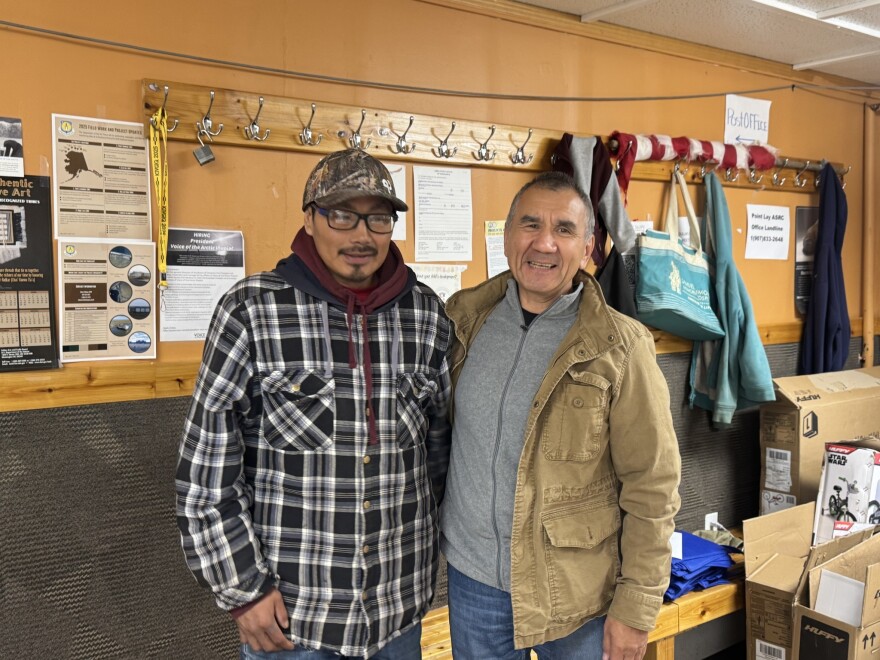Robert Qaummaluk Lisbourne remembers how, when he was growing up, walruses started to beach near Point Lay in large numbers. It was always an exciting time for local hunters. But he said a stream of boats and gunfire startled the animals, causing them to rush to the water, crushing some of the young pups. Since then, Lisbourne said, hunting practices have changed.
"When they first started coming, everyone was hunting them," Lisbourne said. "We came together and we said, 'We gotta find a better way to hunt these animals without causing the stampede.'"
Lisbourne is a hunter and a member of the North Slope Borough Fish and Game Management Committee. He said Point Lay residents now try to hunt walruses when there are only a few of them on the beach. They also ask pilots and mariners to avoid flying too low or boating too fast near the animals during haulouts.
Lisbourne will share his knowledge about walruses with the U.S. Geological Survey and the University of Alaska Museum of the North later this summer. The project will include a walrus drone survey and interviews with local hunters who rely on them for subsistence.The goal is to record traditions that are important to Point Lay residents – and to maintain collaboration across the Arctic.
"It would be all about how Inupiaq communities see this walrus haulout, and its current condition and what should be done to preserve walrus and their habitat," said Eduard Kergytagyn Zdor, an anthropology postdoctoral fellow at the University of Alaska Fairbanks who will help with interviews. "This is about how to help local community to deal with modern challenges, including climate change."

Zdor is a Chukchi Indigenous leader, originally from Chukotka in Eastern Russia, where walrus is also a traditional subsistence resource. He researched and advocated for subsistence hunting back home before moving to the U.S. 10 years ago.
Walrus research is one of many areas where Russian and American scientists, as well as Indigenous experts, used to work together. Russia's invasion of Ukraine in 2022 put a strain on relations between the countries – and on research collaborations. Zdor said he would like this project to be a link between Chukotka and Alaska.
"This is what we are dreaming about, me and people like me here in Alaska and Russia as well, my fellow villagers," he said. "It was a long time ago, almost 30 years ago, when the Soviet Union collapsed, and we just realized that we are not alone here in the Arctic, our neighbors – they are really the same."
In Alaska, female walruses traditionally rest on sea ice. But that trend has been shifting, according to Anthony Fischbach, a wildlife biologist with USGS who has been leading walrus population surveys.
"After 2007, things really changed, where sea ice would dissipate in almost all years," Fischbach said. "That was a fundamental change in their behavior."
Fischbach said that now, the vast majority of female and young animals from the Pacific walrus population – tens of thousands of them – come to Point Lay beaches and feed for several weeks before migrating over to Russia.

Lisbourne has been working with walrus biologists, making sure they follow safety protocols during regular surveys and don't harm the animals.
"We subsistence hunt these animals, and it's a part of us of who we are," he said. "We've been working together – the Native village of Point Lay and the walrus biologists. We are protecting the animals."
Some walruses are slowly starting to approach Point Lay right now, Lisbourne said, though it is still unclear if there will be a massive coastal haulout this year.
Zdor said it will take several years to analyze the interviews and share the final narrative with the village, which could be helpful for working with wildlife management agencies.
After the project is done, Zdor said he hopes Lisbourne will continue documenting local knowledge.
For Lisbourne, exchanging walrus knowledge with Zdor from Chukotka is exciting.
"They get more walrus than we do on our beaches, on Russia side – they get the double amount. So it's going to be interesting to work with Eduard and learn from him too," Lisbourne said. "We're going to be learning from each other, actually."
Correction: This story was updated to reflect that scientists observe tens of thousands of walruses each time they come ashore in Point Lay.


